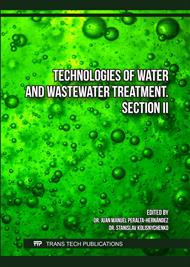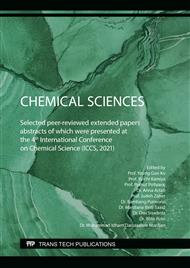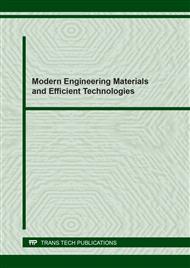[1]
S.P. Sam, H.T. Tan, K. Sudesh, R. Adnan, A.S.Y. Ting, S.L. Ng, Phenol and p-nitrophenol biodegradations by acclimated activated sludge: Influence of operational conditions on biodegradation kinetics and responding microbial communities, J. Environ. Chem. Eng. 9 (2021) 105420.
DOI: 10.1016/j.jece.2021.105420
Google Scholar
[2]
A. Priyadarshini, M.M. Sahoo, P.R. Raut, B. Mahanty, N.K. Sahoo, Kinetic modelling and process engineering of phenolics microbial and enzymatic biodegradation: A current outlook and challenges, J. Water Process Eng. 44 (2021) 102421.
DOI: 10.1016/j.jwpe.2021.102421
Google Scholar
[3]
A. Dzionek, D. Wojcieszyńska, U. Guzik, Natural carriers in bioremediation: A review, Electron. J. Biotechnol. 23 (2016) 28–36.
DOI: 10.1016/j.ejbt.2016.07.003
Google Scholar
[4]
T. Mehrotra, S. Dev, A. Banerjee, A. Chatterjee, R. Singh, S. Aggarwal, Use of immobilized bacteria for environmental bioremediation: A review, J. Environ. Chem. Eng. 9 (2021) 105920.
DOI: 10.1016/j.jece.2021.105920
Google Scholar
[5]
S.P. Sam, R. Adnan, S.L. Ng, Statistical optimization of immobilization of activated sludge in PVA/alginate cryogel beads using response surface methodology for p-nitrophenol biodegradation, J. Water Process Eng. 39 (2021) 101725.
DOI: 10.1016/j.jwpe.2020.101725
Google Scholar
[6]
B.E. Rittmann, Biofilms, active substrata, and me, Water Res. 132 (2018) 135–145.
DOI: 10.1016/j.watres.2017.12.043
Google Scholar
[7]
A.S. Oberoi, L. Philip, Performance evaluation of attached biofilm reactors for the treatment of wastewater contaminated with aromatic hydrocarbons and phenolic compounds, J. Environ. Chem. Eng. 5 (2017) 3852–3864.
DOI: 10.1016/j.jece.2017.07.053
Google Scholar
[8]
M. Ahmad, S. Liu, N. Mahmood, A. Mahmood, M. Ali, M. Zheng, J. Ni, Effects of porous carrier size on biofilm development, microbial distribution and nitrogen removal in microaerobic bioreactors, Bioresour. Technol. 234 (2017) 360–369.
DOI: 10.1016/j.biortech.2017.03.076
Google Scholar
[9]
Y. Zhao, D. Liu, W. Huang, Y. Yang, M. Ji, L.D. Nghiem, Q.T. Trinh, N.H. Tran, Insights into biofilm carriers for biological wastewater treatment processes: Current state-of-the-art, challenges, and opportunities, Bioresour. Technol. 288 (2019) 121619.
DOI: 10.1016/j.biortech.2019.121619
Google Scholar
[10]
G. Buitrón, I. Moreno-Andrade, Biodegradation kinetics of a mixture of phenols in a sequencing batch moving bed biofilm reactor under starvation and shock loads, J. Chem. Technol. Biotechnol. 86 (2011) 669–674.
DOI: 10.1002/jctb.2566
Google Scholar
[11]
M. Mehrpouya, H. Vahabi, M. Barletta, P. Laheurte, V. Langlois, Additive manufacturing of polyhydroxyalkanoates (PHAs) biopolymers: Materials, printing techniques, and applications, Mater. Sci. Eng., C 127 (2021) 112216.
DOI: 10.1016/j.msec.2021.112216
Google Scholar
[12]
B. Kunasundari, V. Murugaiyah, G. Kaur, F.H.J. Maurer, K. Sudesh, Revisiting the single cell protein application of Cupriavidus necator H16 and recovering bioplastic granules simultaneously, PLoS One 8 (2013) e78528.
DOI: 10.1371/journal.pone.0078528
Google Scholar
[13]
A. Hiraishi, S.T. Khan, Application of polyhydroxyalkanoates for denitrification in water and wastewater treatment, Appl. Microbiol. Biotechnol. 61 (2003) 103–109.
DOI: 10.1007/s00253-002-1198-y
Google Scholar
[14]
American Public Health Association, Standard Method for the Examination of Water and Wasterwater, 21st ed., American Public Health Association/American Water Works Association/Water Environment Federation, Washington DC, (2005).
DOI: 10.1002/j.1551-8833.1932.tb18153.x
Google Scholar
[15]
S. Pradhan, A.J. Borah, M.K. Poddar, P.K. Dikshit, L. Rohidas, V.S. Moholkar, Microbial production, ultrasound-assisted extraction and characterization of biopolymer polyhydroxybutyrate (PHB) from terrestrial (P. hysterophorus) and aquatic (E. crassipes) invasive weeds, Bioresour. Technol. 242 (2017) 304–310.
DOI: 10.1016/j.biortech.2017.03.117
Google Scholar
[16]
M.A. Hassan, E.K. Bakhiet, S.G. Ali, H.R. Hussien, Production and characterization of polyhydroxybutyrate (PHB) produced by Bacillus sp. isolated from Egypt, J. Appl. Pharm. Sci. 6 (2016) 46–51.
DOI: 10.7324/japs.2016.60406
Google Scholar
[17]
G.G. Biradar, C.T. Shivasharana, B.B. Kaliwal, Isolation and characterization of polyhydroxybutyrate (PHB) producing Bacillus species from agricultural soil, Eur. J. Exp. Biol. 5 (2015) 58–65.
Google Scholar
[18]
S.A. Mirbagheri, M. Bagheri, M. Ehteshami, Z. Bagheri, M. Pourasghar, Modeling of mixed liquor volatile suspended solids and performance evaluation for a sequencing batch reactor, J. Urban Environ. Eng. 9 (2015) 54–65.
DOI: 10.4090/juee.2015.v9n1.54-65
Google Scholar
[19]
E.N. Banadda, I.Y. Smets, R. Jenné, J.F. Van Impe, Dynamic modeling of filamentous bulking in lab-scale activated sludge processes, IFAC Proc. Vol. 37 (2004) 383–388.
DOI: 10.1016/s1474-6670(17)31841-4
Google Scholar
[20]
N.A. Yusoff, S.A. Ong, L.N. Ho, Y.S. Wong, F.N. Mohd Saad, W.F. Khalik, S.L. Lee, Evaluation of biodegradation process: Comparative study between suspended and hybrid microorganism growth system in sequencing batch reactor (SBR) for removal of phenol, Biochem. Eng. J. 115 (2016) 14–22.
DOI: 10.1016/j.bej.2016.07.018
Google Scholar
[21]
S.P. Sam, S.L. Ng, R. Adnan, Kinetics of biodegradation of phenol and p-nitrophenol by acclimated activated sludge, J. Phys. Sci. 29 (2018) 107–113.
Google Scholar




